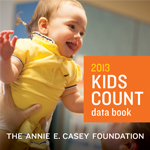It’s been a slow recovery. With the January release of CFED’s annual 2014 Assets and Opportunity Scorecard, we have further proof of this fact. The report, Treading Water in the Deep End, shows many American families are financially insecure, and this includes a growing number of Oklahomans.
 In Oklahoma, it is estimated 49% of households live in a persistent state of financial insecurity, with no little or no savings to cover emergencies. This is up from last year’s estimate of 43.8% of Oklahomans who were considered “liquid asset poor.” Poor showings in areas related to income, assets, healthcare and education contributed to Oklahoma’s overall rank of 31, compared to other states.
In Oklahoma, it is estimated 49% of households live in a persistent state of financial insecurity, with no little or no savings to cover emergencies. This is up from last year’s estimate of 43.8% of Oklahomans who were considered “liquid asset poor.” Poor showings in areas related to income, assets, healthcare and education contributed to Oklahoma’s overall rank of 31, compared to other states.
The Assets and Opportunity Scorecard examines the financial security of Americans by assessing states based on 69 different outcome measures. The measures are grouped into five broader categories: 1) Financial Assets and Income, 2) Business and Jobs; (more…)


 Yet another harsh side effect of eligibility guidelines is called the “Cliff Effect.” It refers to situations where a small increase in income leads to an abrupt end to a critical benefit. Two work support benefits often associated with income limits are child care assistance, which makes daycare affordable for working parents, and
Yet another harsh side effect of eligibility guidelines is called the “Cliff Effect.” It refers to situations where a small increase in income leads to an abrupt end to a critical benefit. Two work support benefits often associated with income limits are child care assistance, which makes daycare affordable for working parents, and 

 KIDS COUNT estimates 216,000 Oklahoma children, or 23% of our state’s child population, were living in poverty as of 2011. Around 35,136 of Oklahoma kids in poverty are located right here in Tulsa County, according to a 2010 estimate by the
KIDS COUNT estimates 216,000 Oklahoma children, or 23% of our state’s child population, were living in poverty as of 2011. Around 35,136 of Oklahoma kids in poverty are located right here in Tulsa County, according to a 2010 estimate by the 
 ith the understanding this in no way represents the entire list of issues raised by the documentary.
ith the understanding this in no way represents the entire list of issues raised by the documentary.  American’s underfed families. The screening will feature a new documentary called
American’s underfed families. The screening will feature a new documentary called 
